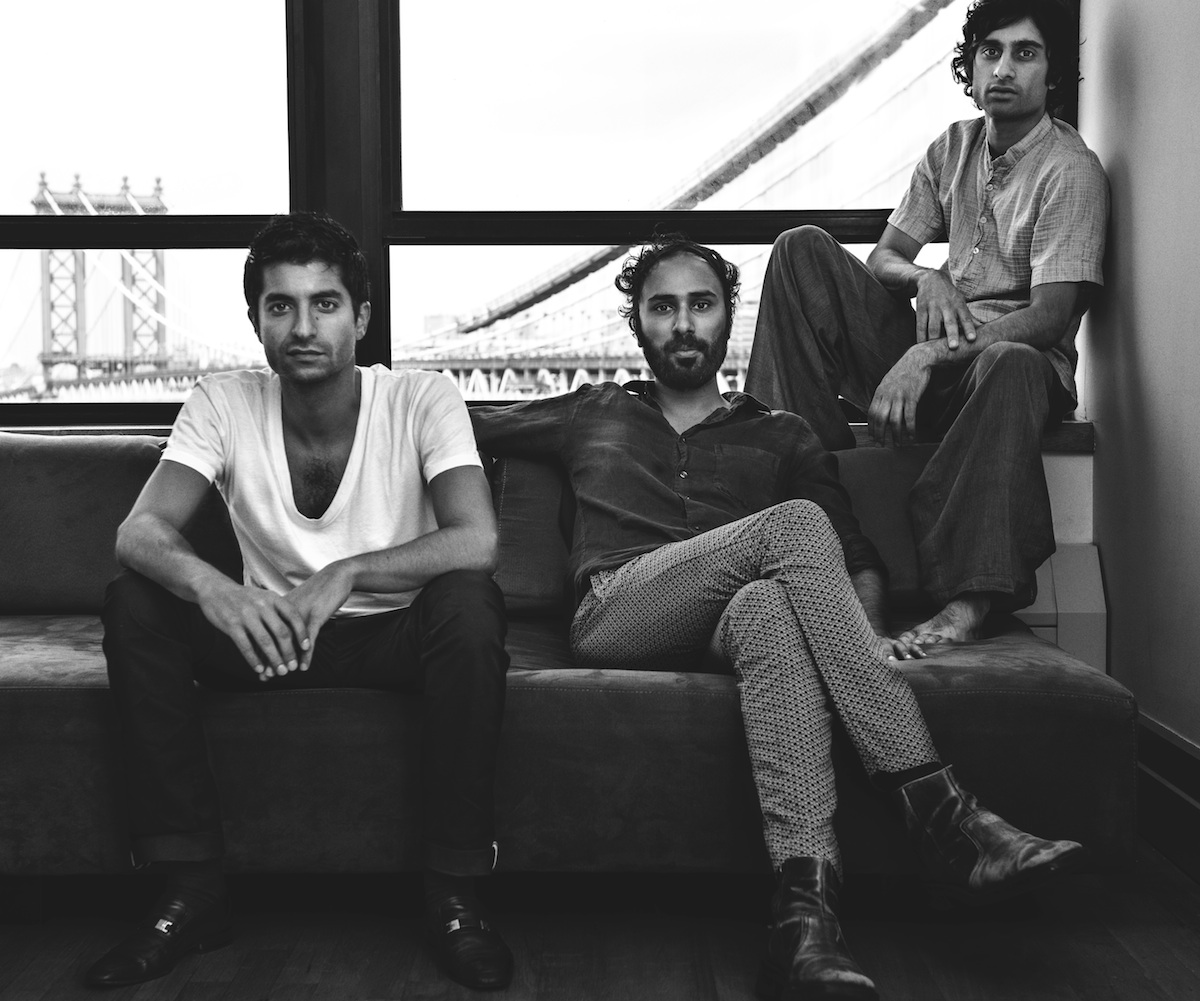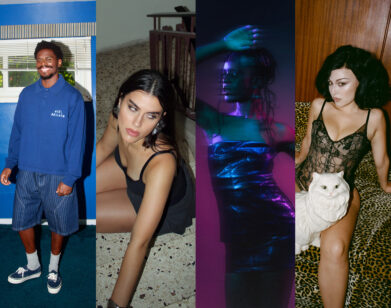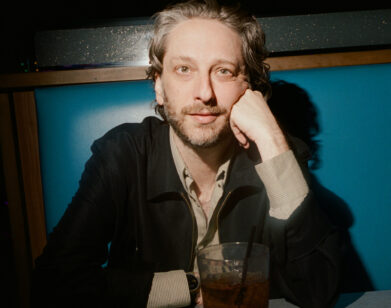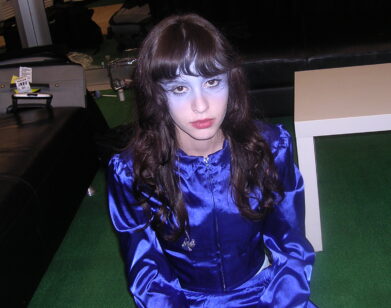Dawn of Midi’s Circuit City

ABOVE: DAWN OF MIDI. PHOTO BY CHRISTOPHER GABELLO
Dawn of Midi is a trio of grand piano, upright bass, and drums, from Pakistan, India, and Morocco respectively. They met at CalArts and now live in New York City, and you would guess from looking at them that they’d be a jazz combo. But these three use extended techniques more familiar to John Cage than to Charles Mingus: playing from within the piano while also on the keys, emulating African talking drums with the bass, altering the drumset acoustically to sound electronic. Dysnomia, the sophomore record from the Brooklyn trio, is now out and will be celebrated with an album release show at (Le) Poisson Rouge tonight. It is a feat of composition, endurance, and innovation, moving and addictive in its disguise of acoustic music as electronic.
The sound of this record is singular, but needs explanation. It’s a kind of approach to electronic music that’s not actually electronic—a kind of circuitous, familiar/unfamiliar tweak of timbre and close melody that is impossible not to groove to. Though Dawn of Midi’s previous, debut album was completely improvised (the band used to rehearse in pitch blackness) this one, which took two years to compose, couldn’t be more different: every single note of these head-bobbing polyrhythms is meticulously placed, landing somewhere between Squarepusher and Steve Reich. We met with two members of Dawn of Midi in Manhattan while the third Skyped in from Morocco.
DALE EISINGER: Amino, where are you?
AMINO BELYAMANI: I’m in Rabat actually, in the outskirts of Rabat right now. I’m looking out over at empty fields of farmland.
AAKAASH ISRANI: Yes!
EISINGER: Dawn of Midi, explain to us who you are and what you are.
ISRANI: We’re a band.
EISINGER: Where did you meet? What’s your history?
ISRANI: Amino is a Moroccan boy. He’s a Moroccan man from Casablanca. He studied in Paris and then came to Los Angeles for Cal Arts. Qasim was born in the States. I was born in India. But we also ended up at Cal Arts during the same time. And we played tennis.
QASIM NAQVI: We were friends before we ever started playing music. It was a lot of social activities and a lot of partying. And then one day we decided to get together and play for the hell of it.
EISINGER: Even as far back as that first rehearsal, were you practicing in pitch blackness?
BELYAMANI: I think we did it from the very beginning.
EISINGER: How would you explain that choice to people who aren’t musicians?
NAQVI: For me, it was very challenging because I’d have no sense of what I was playing on the drums, when we were playing in a place that is completely pitch black. And at times I wouldn’t even know what I was going for, what I was hitting. And eventually you have to rely entirely on your sense of hearing.
BELYAMANI: Like a blind man.
NAQVI: It’s a valuable exercise.
EISINGER: Are blind people better at music?
BELYAMANI: Absolutely. This trip to Morocco, so far I’ve been hanging out with this phenomenal musician who’s self-taught, and he’s almost legally blind, and he plays every instrument, and he’s got an incredible ear and perfect pitch.
ISRANI: Dale, I thought I saw you say something on Twitter the other day about the audience listening with their eyes. I said something back to you because I’ve always wanted to do concerts that are in total darkness, just to force the audience to observe just with their ears. We did it once.
EISINGER: How did you convince the venue to do that?
ISRANI: It was just at a weird place in Gowanus, and there were no rules, so we just shut off all the lights when we played. I think it went well, but I don’t think Qasim could see his drums at all.
NAQVI: Yes, I have a problem with that.
ISRANI: I don’t know if (Le) Poisson Rouge is going to let us do that. Maybe we can get some night-vision goggles for Qasim.
EISINGER: Because you’re using a lot of extended techniques, playing with different implements on unorthodox parts of the kit —it would be pretty difficult in the dark.
NAQVI: Well, it’s weird. I have certain things to mold these sounds. On one of my drums, I have this big gong and it takes up pretty much the entire diameter of the thing, and I have to hit the drum in a very specific kind of way.
EISINGER: Explain the extended techniques you use a little more, all of you. It sounds like the bass is emulating talking drums sometimes. The drums sound electric sometimes, and Amino is playing inside the piano.
BELYAMANI: What inspired me to do it was a duo record of Chick Corea and Bobby McFerrin. McFerrin does all this crazy vocal stuff, and Chick Corea improvises around it, and at some point he starts playing this really rhythmic groove using his left hand to mute the strings on the grand piano and using his right hand to play the keys of the grand piano as if he’s playing normal piano. I fell in love with that sound. Every now and then I would use it when I used to improvise, but I never really developed it past the sound of changing what I was playing. That was the extent of my understanding and application of that technique. But over the last three or four years, being very interested in my roots, and Moroccan music, African music, I started trying to emulate what those stringed instruments—like in Mali, the kora, or the ardin from Mauritania—trying to emulate that sound with the piano. Slowly but surely, it became something I did all the time, and then with the development of this composition with Dawn of Midi it became clearer and clearer that was the sound. Slowly we started eliminating the piano sound, and at the end the whole piece was that sound. Now there are also two different worlds to this because you can mute the piano above the dampeners or below the dampeners and there the percussive end below but also the harmonic, bell-tone zone above. You hear that in the record.
EISINGER: Has having to do it with a grand piano hampered your ability to tour at all?
ISRANI: We did it on a Rhodes recently, actually, at a venue on the Lower East Side called Pianos, which, ironically, does not have a piano. I use a delay pedal to emulate similar worlds on the piano.
EISINGER: What about the bass?
ISRANI: The bass is not so crazy. It was just about finding a sonic world that matched what the piano was doing. There are a lot of harmonics; it’s about 80 percent using the harmonics of the instrument. And since Amino is playing the harmonics of a string and I’m playing the harmonics of a string, a lot of times it can be hard to tell which sound is coming from where. This is something we did on purpose. But the technique is not anything extraordinary; it’s more about the sound selection.
EISINGER: And you, Qasim?
NAQVI: Because the piano and the bass, frequency-wise, take up a lot of the mid- to low register, the drums, ironically, had to inhabit the higher-frequency spectrum. So we had to do all these things to the drums to get them to sound higher-pitched. I would take fishing wire, plastic fishing wire, and tape it underneath the top heads of the drums so I could get a buzz. It sounds kind of electronic. But also in a lot of folk musics, like Moroccan music for instance, they use these drums that use one wire line that creates this buzz. So we did things like that. I had two different snare drums that I used that were tuned strangely.
BELYAMANI: And no cymbals!
NAQVI: Right. Because the piece is so rhythmic, pure rhythm, that any drum or cymbal that has a long decay would have taken away from the dialogue that’s going on with the instruments. So there’s no cymbals. Just a hi-hat. And also we used a separate bass drum that I would hit the shell of with a mallet that would create a wooden attack, like an echo.
EISINGER: You guys have thought about this so hard. I know you didn’t write any of it down—what kind of vocabulary did you use to create this?
NAQVI: A lot of frustration.
ISRANI: We met a lot and we tried a lot and we threw away a lot. If we were excited about something we would keep it, and if we would stay excited about something we would keep it. If we got tired of it, we wouldn’t keep it. So the things we kept getting excited about stayed. We’ve always had a really easy time improvising together, and that’s one way of communicating. And this was another way of communicating where we actually had to talk about what we were doing for a year. That was challenging because it’s easier to talk with just music. But I don’t think we could have arrived at this just improvising. So it was a worthwhile trial to go through.
NAQVI: We also recorded every single rehearsal.
ISRANI: Yeah. We would sort of isolate things that we liked that we were working on and we’d use those as a reference.
NAQVI: How many recordings do we have?
ISRANI: Probably about 150.
NAQVI: We rehearsed on average three times a week for two years on this.
EISINGER: Do you have any interest in releasing those 150 recordings?
ISRANI: I think it would just be better for us to get into a fist fight after each show on stage. That would be a better depiction of the process.
EISINGER: I feel like no one is spending two years on a piece these days.
NAQVI: I have never heard of a new music ensemble spending two years on one piece.
BELYAMANI: And what’s particular about Dysnomia is that it requires a kind of discipline. It took time to write it. It took time to learn it of course. But not only that, there’s an extra dimension which is the mystical element in music. And for Dysnomia the mystical element is a particular swing, a particular… you can’t put a word to it. It’s a feeling. It’s either right or it sounds retarded. So to get it right it takes a lot of patience and practice. So it’s not like a composed piece where you learn and play the content and once you get the content right that’s it. Here, you can play the content right, but it’s not right because there’s that extra dimension that’s missing.
ISRANI: You have to almost sound like three people from the same village playing folk music their whole life together. And in order to sort of get that level of intimacy and time-feel, we had to play a lot and practice a lot. That’s hard to make up for when you’re hearing music in folk traditions. There are people who are just growing up playing that every day they don’t think of it was rehearsing. It’s just their life. And they sound a certain way because of that.
EISINGER: On that note, how did your history with your own folk music play into this record?
BELYAMANI: It was always part of my life, but I never thought it was a serious thing, just something that people do when they get together at parties or weddings. So I used to do that a lot. I would play darbuka, which is actually not even Moroccan—it comes from Egypt and the Middle East. And then one day I started taking a little more interest. I would start going to different parts of Morocco to play with the local musicians but not very seriously. As kind of a hippie thing. And then once I got to Cal Arts and studied music from different parts of the world it made me wonder and be like, “Maybe I actually have a rich culture that I need to study, too, like I was studying at Cal Arts.” So every year I would go back to Morocco and try and learn and not just play for fun. And I bought more instruments and started to learn them. It’s always been around, and I’ve always have that exposure, and these rhythms have always been speaking to me. I’m so attached to them I can’t imagine my life without playing those rhythms.
ISRANI: For me, there’s not a whole lot of Indian influence music on this record. It comes a lot from being a lot around Cal Arts and being exposed. I was always sort of a nerd about polyrhythms, and then being exposed to African music was an eye-opening thing. That’s been the place that particularly on this record that’s been my vantage point, having an interest there and hearing music from Africa and being mesmerized ever since and wanted ever since I first heard it to reinterpret it in a band.
BELYAMANI: And Susana Baca I know was an influence on you as well.
ISRANI: There were many things that blew my mind wide open, that being one of them, but it was also traced back to African music. In that case, Susana Baca is Peruvian but with a lot of African elements.
EISINGER: You all have cited one particular drummer at Cal Arts who opened up your perceptions.
NAQVI: You’re talking about Alfred, Alfred Ladzekpo.
BELYAMANI: First of all he’s a great musician and a great drummer. But also the real depth of our experience that comes from a profound stubbornness that comes from an old African way of thinking that was so deep, and he really taught us how to use our ears and to listen and to intervals of time and to really listen to different sounds and control tones in a drum, and he never allowed you to write stuff down or record the lessons. He’s very stubborn that way, but he taught us all how to really listen and it was really a deep experience. He’s an amazing teacher.
NAQVI: Alfred teaches a form of drumming called ewe. It’s from Ghana and it dates back four or five hundred years.
BELYAMANI: They don’t know for sure, but most of those pieces are from the 18th century.
NAQVI: And these are pieces where it’s all completely worked out. There’s no improvisation whatsoever. It’s just like an ancient kind of drum corps. Personally, too, I felt something else there. When slaves were brought over from Ghana, the music came with them. I, at least, could hear the early trappings of American music in terms of rhythm and these things. You realize it’s the whole kind of circuit that completes in terms of your understanding of rhythm of America.
BELYAMANI: And even in some of the songs, because he sang so beautifully and he taught us these songs that were so bluesy and the harmonies remind you of Muddy Waters and all that but even more ancient.
ISRANI: It’s like listening to the blues before the blues existed. I actually got to play music with Alfred a couple weeks ago.
BELYAMANI: I know! You bastard.
ISRANI: He’s since left the U.S. and gone back to Ghana, so that was a real, real pleasure.
BELYAMANI: He’s a proper chief of his tribe.
EISINGER: You mentioned the word “circuit” which is a word I’ve thought a lot about in terms of this band. Not just with the influences you’re talking about, but also in terms of dance. I was trying to convince my buddy that you guys are a dance band, though he was really insistent you were a jazz band.
ISRANI: No one’s ever going to be able to fight the debate about what words mean to people. That’s something that everyone fights about, everyone has their own relationship to words. So the jazz or not-jazz thing will never be settled, because no one knows what that word means. But dance, I don’t think that’s necessarily mutually exclusive from jazz. Jazz has been dance music before, too. But as far as the circuit thing, I think it’s about the way the time is being expressed. So in a lot of music, the time is the beat being played by the band, and you’re hearing the beat out loud and you dance along to it. And in this music, a lot of times we’re playing all the stuff around it, but the silences are the beat. And that is felt whether you understand it or not. Like my parents, they don’t understand it, but they feel it. They move their head. They tap their feet. Everyone who listens to the record moves.
I think it has everything to do with positive and negative space. You know that famous image that if you look at the white space it’s a vase, and if you look at the black space it’s a face? This positive and negative space thing—it’s like that with time. So playing everything except the beat that stays in the negative space. But the beat becomes even more apparent in the body of the listener. So when we talk about the completing the circuit, we’re playing that fundamental, crucial aspect to the listener and they’re completing the circuit by feeling it and dancing.
BELYAMANI: And that’s what usually induces trance. That’s why it’s hard to trance over a rock-‘n’-roll concert. Even though it can be an amazing band, it’s not necessarily easy to induce a trance because you’re playing what you’re hearing. When your body is playing what you’re not playing, and it’s completing the full circuit, then the trance comes along naturally.
EISINGER: So the body is the instrument of trance.
BELYAMANI: Absolutely.
ISRANI: And dance is the expression of trance in a lot of ways. It’s us expressing time physically.
DAWN OF MIDI’S DYSNOMIA IS OUT NOW. THE BAND WILL PLAY (LE) POISSON ROUGE TONIGHT, SEPTEMBER 3. FOR MORE ON DAWN OF MIDI, VISIT ITS WEBSITE.






